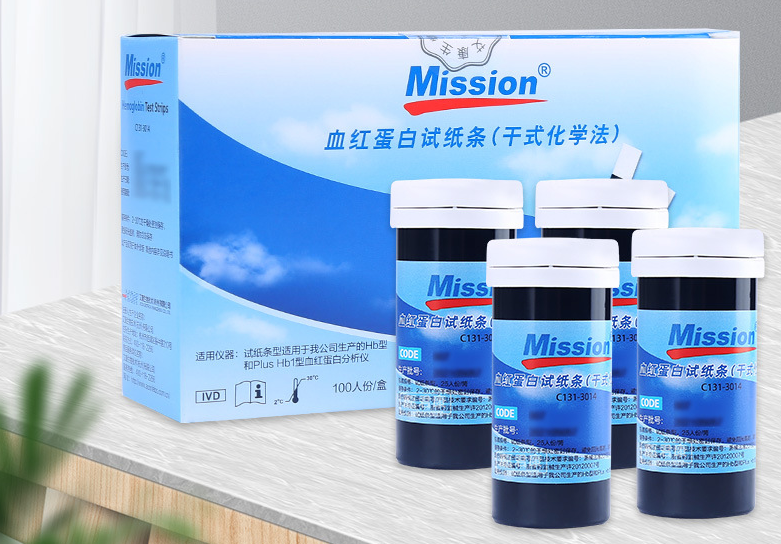
For testing hemoglobin (Hb) in human whole blood.
For in vitro diagnostic use only.
INTENDED USE
The Hb Hemoglobin Test Strips (Whole Blood) are firm plastic strips onto which a multilayer dry reagent is affixed and are intended to be read on the Mission® Hb Hemoglobin Meter. The test strips function by lysing erythrocytes and converting the released hemoglobin into methemoglobin. This test is for the quantitative determination of hemoglobin (Hb) and calculated hematocrit (Hct) in capillary and venous whole blood. The test strips are for professional use only.
SUMMARY
Hemoglobin is the main component of red blood cells whose main function is to transport oxygen. The determination of hemoglobin concentration in whole blood is useful in the clinical diagnosis of diseases such as anemia and polycythemia. The measurement range of the Mission® Hb Hemoglobin Testing System is 4.5 ¨C 25.6 g/dL.
PRINCIPLE AND REFERENCE VALUES
Erythrocytes in the specimen are lysed to release hemoglobin. The hemoglobin is converted to methemoglobin. The intensity of the color produced from this reaction is proportional to the hemoglobin concentration. Reference values are listed in the chart below:
|
Men |
13.0 ¨C 17.0 g/dL (130 |
¨C 170 g/L, 8.1 |
¨C 10.5 mmol/L) |
|
Women |
12.0 ¨C 15.0 g/dL (120 |
¨C 150 g/L, 7.4 |
¨C 9.3 mmol/L) |
|
Children |
11.0 ¨C 14.0 g/dL (110 ¨C 140 g/L, 6.8 ¨C 8.7 mmol/L) |
||
Reference ranges may vary between laboratories. Every laboratory should establish its own reference range as needed.
REAGENTS AND PERFORMANCE CHARACTERISTICS
Based on the dry weight at the time of impregnation, the concentrations given may vary within manufacturing tolerances.
|
Reagent |
Composition |
|
Sodium dexycholate |
3% w/w |
|
Sodium nitrite |
1.5% w/w |
|
Non-reactive Ingredients |
95.5% w/w |
The performance characteristics of these Hb Hemoglobin Test Strips have been determined in both laboratory and clinical tests. This test has been developed to be specific for the parameters to be measured with the exception of the interferences listed. Refer to the Limitations section for detailed information.
PRECAUTIONS
• For in vitro diagnostic use only.
• The strip should remain in the closed canister until use.
• Do not use after the expiration date.
• Do not touch the reagent area of the strip.
• Discard any discolored or damaged strips.
• All specimens should be considered potentially hazardous and handled in the same manner as an infectious agent.
• The used strip should be discarded according to local regulations after testing.
• Check the code chip before performing a test. Make sure to use the code chip that is included with the canister of strips. Insert the code chip into the code chip slot. The code chip slot is located on the right side of the meter.
STORAGE AND STABILITY
Store as packaged in the closed canister, either at room temperature or refrigerated (2-30ˇăC). Keep out of direct sunlight. Strips are stable through the expiration date printed on the canister label. Remove only enough strips for immediate use. Replace cap immediately and tightly. DO NOT FREEZE. Do not use beyond the expiration date.
Note: Once the canister has been opened, the remaining strips are stable for up to 3 months. Stability may be reduced in high humidity conditions.
SPECIMEN COLLECTION AND PREPARATION
• Acceptable specimens include fresh capillary or venous blood, following NCCLS Guideline H4A4 for capillary blood specimenˇŻs collection.
• Fresh capillary or venous blood specimens must be collected and tested immediately.
• Specimens with EDTA or heparin anticoagulants may be used. Preserved specimens must be kept in a closed container and must be used within 8 hours of collection. Mix stored specimens adequately before testing.
• A Capillary Transfer Tube or pipette should be used to collect capillary specimens for accurate results.



